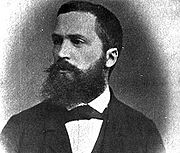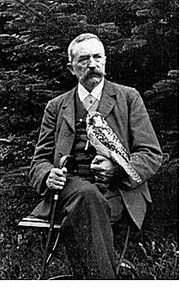
Otto Finsch
Encyclopedia

Braunschweig
Braunschweig , is a city of 247,400 people, located in the federal-state of Lower Saxony, Germany. It is located north of the Harz mountains at the farthest navigable point of the Oker river, which connects to the North Sea via the rivers Aller and Weser....
) was a German
Germany
Germany , officially the Federal Republic of Germany , is a federal parliamentary republic in Europe. The country consists of 16 states while the capital and largest city is Berlin. Germany covers an area of 357,021 km2 and has a largely temperate seasonal climate...
ethnographer, naturalist
Natural history
Natural history is the scientific research of plants or animals, leaning more towards observational rather than experimental methods of study, and encompasses more research published in magazines than in academic journals. Grouped among the natural sciences, natural history is the systematic study...
and colonial explorer.
Biography
Finsch was born at Warmbrunn in SilesiaSilesia
Silesia is a historical region of Central Europe located mostly in Poland, with smaller parts also in the Czech Republic, and Germany.Silesia is rich in mineral and natural resources, and includes several important industrial areas. Silesia's largest city and historical capital is Wrocław...
to Mortiz Finsch and Mathilde née Leder. His father was in the glass trade and he too trained as a glass painter. An interest in birds led him to use his artistic skills for the purpose and an offer from the Austrian Consul led him to visit Bulgaria in 1859. Here he produced a work on the regional birdlife and published his first paper in the Journal fur Ornithologie on the birds of Bulgaria. This experience helped him obtain a curator position at the Reichsmuseum of Natural History in Leiden (1862–1865). In 1864 he became curator of the museum in Bremen and became the director in 1876. He obtained an honorary doctorate from the University of Bonn in 1868 for ornithology but he also took an interest in ethnology. In 1876 he accompanied the zoologist Alfred Brehm
Alfred Brehm
Alfred Edmund Brehm was aGerman zoologist, natural history illustrator and writer, the son ofChristian Ludwig Brehm....
on an expedition to Turkestan
Turkestan
Turkestan, spelled also as Turkistan, literally means "Land of the Turks".The term Turkestan is of Persian origin and has never been in use to denote a single nation. It was first used by Persian geographers to describe the place of Turkish peoples...
and northwest China
China
Chinese civilization may refer to:* China for more general discussion of the country.* Chinese culture* Greater China, the transnational community of ethnic Chinese.* History of China* Sinosphere, the area historically affected by Chinese culture...
. He also became interested in the creation of German colonies in the Pacific and he became a member of the South Sea Plotters, an influential group led by a banker named von Hansemann.

Polynesia
Polynesia is a subregion of Oceania, made up of over 1,000 islands scattered over the central and southern Pacific Ocean. The indigenous people who inhabit the islands of Polynesia are termed Polynesians and they share many similar traits including language, culture and beliefs...
, New Zealand
New Zealand
New Zealand is an island country in the south-western Pacific Ocean comprising two main landmasses and numerous smaller islands. The country is situated some east of Australia across the Tasman Sea, and roughly south of the Pacific island nations of New Caledonia, Fiji, and Tonga...
, Australia
Australia
Australia , officially the Commonwealth of Australia, is a country in the Southern Hemisphere comprising the mainland of the Australian continent, the island of Tasmania, and numerous smaller islands in the Indian and Pacific Oceans. It is the world's sixth-largest country by total area...
and New Guinea
New Guinea
New Guinea is the world's second largest island, after Greenland, covering a land area of 786,000 km2. Located in the southwest Pacific Ocean, it lies geographically to the east of the Malay Archipelago, with which it is sometimes included as part of a greater Indo-Australian Archipelago...
. He returned to Germany in 1882. In 1884 he returned to New Guinea as Bismarck
Otto von Bismarck
Otto Eduard Leopold, Prince of Bismarck, Duke of Lauenburg , simply known as Otto von Bismarck, was a Prussian-German statesman whose actions unified Germany, made it a major player in world affairs, and created a balance of power that kept Europe at peace after 1871.As Minister President of...
's Imperial Commissioner and negotiated for the north-eastern portion of that island, together with New Britain
New Britain
New Britain, or Niu Briten, is the largest island in the Bismarck Archipelago of Papua New Guinea. It is separated from the island of New Guinea by the Dampier and Vitiaz Straits and from New Ireland by St. George's Channel...
and New Ireland
New Ireland (island)
New Ireland is a large island in Papua New Guinea, approximately 7,404 km² in area. It is the largest island of the New Ireland Province, lying northeast of the island of New Britain. Both islands are part of the Bismarck Archipelago, named after Otto von Bismarck, and they are separated by...
, to become a German protectorate. It was renamed Kaiser Wilhelm's Land and the Bismarck Archipelago
Bismarck Archipelago
The Bismarck Archipelago is a group of islands off the northeastern coast of New Guinea in the western Pacific Ocean and is part of the Islands Region of Papua New Guinea.-History:...
. The capital of the colony was named Finschhafen
Finschhafen
Finschhafen is a district on the northeast coast of the Morobe province of Papua New Guinea. It is named after the port of the same name.The port was discovered in 1884 by the German researcher Otto Finsch. In 1885 the German colony of German New Guinea created a town on the site and named it...
in his honour. In 1885 he was the first European to discover the Sepik
Sepik
Sepik may refer to places in Papua New Guinea:*Sepik River*East Sepik - a province*Sandaun - a province formerly known as West Sepik*Sepik region - consisting of East Sepik and Sandaun provincesIn languages it may refer to:...
river, and he named it after Kaiserin Augusta
Augusta of Saxe-Weimar
Augusta of Saxe-Weimar-Eisenach was the Queen of Prussia and the first German Empress as the consort of William I, German Emperor.-Early life:...
, the German Empress.
After returning to Berlin Finsch spent two years as advisor to the Neuguinea-Kompagnie. In 1898 he became curator of the bird collections at the Rijksmuseum in Leiden, and then in 1904 head of the ethnographical department of the Municipal Museum in Brunswick
Braunschweig
Braunschweig , is a city of 247,400 people, located in the federal-state of Lower Saxony, Germany. It is located north of the Harz mountains at the farthest navigable point of the Oker river, which connects to the North Sea via the rivers Aller and Weser....
, where he died.
One of his major works was on the parrots of the world. This was not without its critics, since he often tried to rename genera and apparently so as to obtain authorship.
Some species of parrot bear his name, including the Lilac-crowned Parrot
Lilac-crowned Parrot
The Lilac-crowned Amazon, Amazona finschi, is a parrot endemic to the Pacific slopes of Mexico. Also known as Finsch's Amazon, the parrot is characterized by green plumage, a maroon forehead, and violet-blue crown...
Amazona finschi and the Grey-headed Parakeet
Grey-headed Parakeet
The Grey-headed Parakeet Psittacula finschii is closely related to the Slaty-headed Parakeet which together form a super-species. It occurs from the North-eastern states of India, into Burma, Thailand, Cambodia, Laos and Vietnam....
Psittacula finschii. The monitor lizard Varanus finschi is named after him, as he collected what would become the holotype for this species. The crater Finsch
Finsch (crater)
Finsch is a relatively small lunar crater in the mid-part of Mare Serenitatis that has been completely covered by the mare, forming a ghost crater in the lava plain. It is located to the south-southeast of the crater Sarabhai....
on the Moon
Moon
The Moon is Earth's only known natural satellite,There are a number of near-Earth asteroids including 3753 Cruithne that are co-orbital with Earth: their orbits bring them close to Earth for periods of time but then alter in the long term . These are quasi-satellites and not true moons. For more...
is also named in his honor.
Published works
- Otto Finsch, Catalog der Ausstellung ethnographisher und naturwissenschaftlicher Sammlungen (Bremen: Diercksen und Wichlein, 1877).
- Otto Finsch, Anthropologische Ergebnisse einer Reise in der Sudsee und dem Malayischen Archipel in den Jahren, 1879-1882 (Berlin: A. Asher & Co., 1884).Otto Finsch, Masks of Faces of Races of Men from the South Sea Islands and the Malay Archipelago, taken from Living Originals in the Years 1879-82 (Rochester, NY: Ward's Natural Sciences Establishment, 1888).
- Otto Finsch, Ethnologische Erfahrungen und Belegstucke aus der beschreibender Katalog einer Sammlung in K.K. Naturahistorischen Hofmuseum in Wien (Wien: A. Holder, 1893).
- Finsch, O. 1867-68. Die Papageien / monographisch bearbeitet von Otto Finsch Leiden:Brill http://www.biodiversitylibrary.org/bibliography/44767
- with Gustav HartlaubGustav HartlaubKarel Johan Gustav Hartlaub was a German physician and ornithologist.Hartlaub was born in Bremen, and studied at Bonn and Berlin before graduating in medicine at Göttingen. In 1840, he began to study and collect exotic birds, which he donated to the Bremen Natural History Museum. He described some...
Die Vögel der Palau-Gruppe.Über neue und weniger gekannte Vögel von den Viti-, Samoa- und Carolinen-Inseln.Journal des Museum GodeffroyMuseum GodeffroyThe Museum Godeffroy was a museum in Hamburg, Germany, which existed from 1861 to 1885.The collection was founded by Johann Cesar VI. Godeffroy, who became a wealthy shipping magnate a few years after the expansion of the his trade towards Australia and the South Seas. His expert collectors and...
, Heft 8, 1875 and Heft 12, 1876.
Other sources
- Herbert Abel, Otto Finsch: Ein Lebensbild Zur 50. Wiederkehr des Todestages am 31. Januar 1967. Jahrbuch der Schlesischen Friedrich-Wilhelms-Univeritaet zu Breslau. Band XII. Wuerzburg: Holzner-Verlag.

